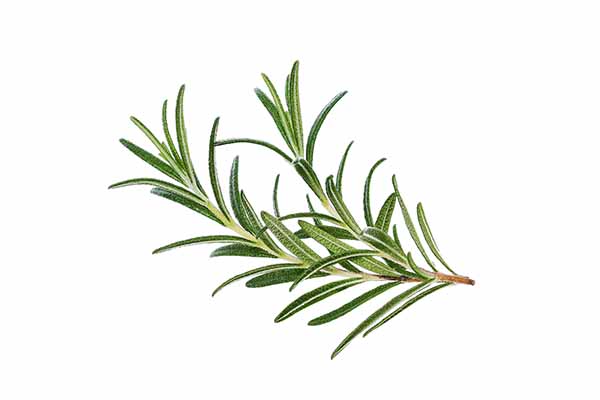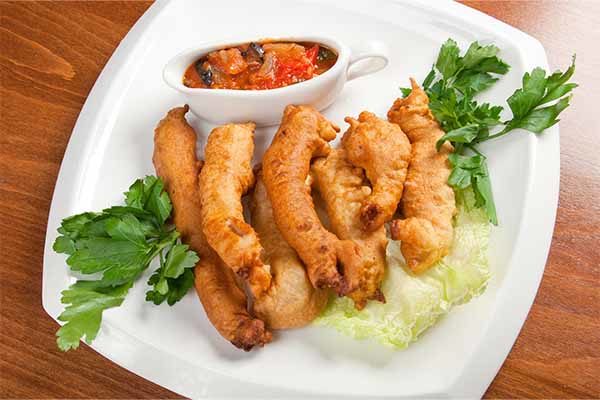Breaded meats…the Germans call it schnitzel, while Poles refer to it as kotlet, a nod to the English translation of cutlet, which suggests a thinly sliced piece of meat, often pounded and marinated to tenderize and then coated with breadcrumbs and fried or baked, or both. The French give it a glamourous twist with the name of escalope, as do the Italians by calling it milanese. Katsu is the term used in Japan for the breaded version, while tempura describes meat pieces that are battered and deep fried.
All translations — often with regional twists — are part of US cuisine and are responsible for everything from nuggets to wings to chicken-fried steak, which is tenderized cube steak fried in the same manner as bone-in chicken. This Southern favorite resembles Wiener schnitzel, an iconic Austrian dish of breaded and fried veal.
Take note, breadings and batters are two very different topical applications to meat and poultry. But don’t worry about the vernacular, as there are many crossovers of the two as well as misuse of the terms. Whatever name you call it, there’s a great deal of opportunity to introduce unique flavors, textures and an element of adventure through this topical application. It’s also an economical approach to using lower-quality cuts of meat, in whole muscle or comminuted formats. The breading extends the protein, while marinating and frying assists with tenderizing and providing succulence.
Innovation opportunities
Consumers continue to seek out convenience with value-added meat and poultry, which includes breaded and battered products, according to the 2023 Power of Meat study. This is expected to continue, as 35% of shoppers surveyed for the study said they often do not have as much time to prepare dinner as they would like.
This is fueling innovation in fully cooked, heat-and-eat products. Breading and batter technology invites meat and poultry processors to add an extra dimension of character to ordinary protein. Adding spices, herbs, seeds, nuts, and even fruit and vegetable particulates to breadings is a way to differentiate in the marketplace. Global flavor profiles are welcome in this space.
Think Italian-seasoned, parmesan-encrusted chicken filets and black sesame seed panko crumbed pork strips. How about gyros nuggets coated with pita crumbs or a beef kabob with a schnitzel breading? Try bratwurst bites with beer batter and pretzel breading. The possibilities are endless as suppliers get creative with their offerings.
To help parents feel better about serving their kids nuggets multiple times per week, formulators are upgrading them with whole grain breadings, sometimes with hidden vegetables or extra fiber. Adding some international flavor to these coatings is a great way to expand their palates at an early age.
“We are seeing brands use whole grains or even ancient grains in tempura-style battered products, leveraging their ‘health halos’ to bring added nutritional appeal to this kid-friendly, convenient category,” said Conor Sullivan, senior technical services specialist, Cargill, Minneapolis. “Oil selection has a big impact on the finished products’ nutritional credentials, too. Here, canola oil, which is low in saturated fats, is a good choice. The big story in the breading and batter space remains the ongoing quest to make products crispier and to help them sustain that texture longer,” Sullivan said.
That’s challenging, even with flash-freezing technology. And while crispy is desirable, high-fat content is not.
“Oil absorption is a common concern in this space,” said Melissa Machen, principal technical account manager, protein ingredients at Cargill. “No one wants a soggy product. To prevent fried products from absorbing too much oil, we often recommend incorporating corn dextrins into the formula. They create a protective film layer around the product, reducing oil pick up. Oil temperature also plays a big role in oil absorption. The right temperature can help prevent excess oil absorption.”
 Source: @SUPERHEANG168, ANGINTARAVICHIAN — STOCK.ADOBE.COM
Source: @SUPERHEANG168, ANGINTARAVICHIAN — STOCK.ADOBE.COM
Kemin, Des Moines, Iowa, now offers a fat block technology that is designed for industrial fried foods. The functional protein system forms a micro-barrier around items that helps inhibit frying oil from being absorbed into the breading. Depending on the coating system, fat uptake may be reduced by 10% to 30%. Less moisture is also lost in the product during frying, which can result in increased yield.
“Our new fat block technology provides manufacturers the opportunity to meet the label claims and product attributes consumers desire, while achieving greater yields,” said Courtney Schwartz, marketing director at Kemin. “It has excellent flavor with no competing flavors.”
To further help meat and poultry processing, an additional line of functional proteins provides processors with a clean-label alternative to phosphates, which have historically been used to improve the textural and quality parameters of proteins by increasing yield and water-holding capacity.
“Muscle proteins in meat and poultry are large, highly structured molecules, which limit their ability to fully interact with water or other proteins,” Schwartz said. “Our patented meat and water technology expands the protein structure of deboned muscle trim, exposing water-binding sites that were previously unavailable. This allows meat and poultry products to retain more moisture utilizing a label-friendly ingredient, and in many cases a reduction in raw material (meat) in the formulation.”
These ingredients are manufactured from various cuts of meat, including beef, pork and poultry, and are labeled as “meat” or “meat plus water” in the United States when used in whole muscle and processed meat and poultry. The liquid ingredient is used in a manner similar to traditional yield-enhancement products.
“Product quality is a key concern, and while not an innovation per se, it is an overriding consideration for brands, particularly as it relates to color,” said Sullivan. “Achieving consistency of color is a big topic with our customers, especially with tempura batters. Consumers expect every nugget, strip or patty to have the same light, flaky color. Many factors contribute to that final product color, including the color of dry ingredients, like corn flour, the color of the frying oil, the quality of the frying oil and the oil’s oxidative stability. Not every ingredient supplier can deliver that level of consistency, lot after lot.
“Air fry technology is also making waves with breaded and battered products. We’re even seeing some manufacturers use this technology as part of their production process as a way to reduce fat,” Sullivan said. “Some oil is still incorporated into these systems — either directly in the breading/batter or as a quick spray coating — so you still get some of that indulgence, but the end-product will have a lot less fat than traditional nuggets, strips and patties. That said, because oil is topical, factors like oxidation stability and flavor are especially important. Brands will have the best success with high-quality, premium oils that offer consistent color and a clean-flavor profile.”
When applying oil topically, it makes sense to include certain plant extracts in the oil, as well as the breading, to retard oxidation and assist with maintaining color, flavor and quality. Rosemary is one such extract. One of the active components in rosemary is carnosic acid, which naturally protects the rosemary plant from heat and light when growing in the wild. That same compound provides a natural way to combat pro-oxidants, such as oxygen, light and temperature, thereby helping retain product quality. Rosemary can be blended with other plant extracts to offer different levels of protection.
Green tea extract may also assist. The main difference between the two is that green tea extract has a lower negative flavor contribution to the final product. Thus, using a lower level of rosemary extract in combination with green tea extract allows the manufacturer to increase the natural plant extract usage rate, often resulting in an extract blend that works better in the meat product than using rosemary alone. Research also shows that when acerola extract is used in combination with rosemary and green tea extracts, acerola is more effective at delaying early discoloration than either extract alone.
The ascorbic acid in acerola extract works as a reducing agent. It helps keep the iron in myoglobin in its ferrous (reduced) state. Once it’s oxidized to a ferric state, the meat appears brown. Acerola extract also assists with delaying lipid oxidation and is often paired with all-natural food safety ingredients as well as other plant extracts in order to assist with shelf life.
The right breading or batter can literally make or break a protein. Such coatings must be designed to adhere to the protein during manufacturing, distribution, preparation and plating, as well as keep the protein matrix contained and intact.
Batters are wet coatings that are typically a mixture of up to 90% flour and starch, along with a leavening agent (e.g., sodium bicarbonate, egg or even seltzer or beer), and water, oil and seasonings. Wheat flour is standard, with corn, potato, rice and soy flour becoming increasingly more common, in particular if gluten-free is a desired trait.
When applied as the sole coating, batters are light by design. They require deep frying to set, as the high temperature of the oil causes the batter to blow up around the protein, preventing the protein from scorching while locking in flavors and juices. Upon cooling, the batter collapses, encasing the protein.
Such flour batters — often described as tempura or fritter — should not be confused with cornmeal batters. The latter are generously applied to the protein, usually hot dogs, and fry up to be crispy and crunchy. The density of the batter prevents it from expanding during frying.
Breadings on the other hand, are dry coatings. They consist of particulates that stick to the surface of the protein. During cooking, which can be frying, baking or even stove top, the breading dries out instead of the protein it is covering, becoming crisp on the surface while helping the protein stay moist and tender.
Breadings can be as simple as a blend of wheat flour, corn starch and seasoning, or they can be based on bread or cracker crumbs and include granulated nuts and seeds, which bring texture, flavor and extra nutrition in the form of protein and fiber to the coating. Unlike batters with their soft texture, breadings are expected to have a gritty texture.
Many of today’s innovative encrusted proteins rely on larger granulation mixtures of different crumb types to develop unique textures and visual appeal. For example, panko, which is made from bread baked by passing an electric current through the dough in order to make bread without crust, has an airier texture compared to most other bread crumb types, which allows for a crispier finish.
For breaded baked products, an ingredient system with adhesive properties is typically applied first in order to keep the breading in place. This may be an egg wash, a starch or gum solution, or an emulsion such as yogurt, mayonnaise or buttermilk.
Both battered and breaded proteins are dusted with a flour-starch mixture before the coating is applied. This pre-dust is where spices and flavors may be added.
“The pre-dust serves three primary functions. It helps with adhesion of both breadings and batters, it provides a film layer that helps prevent ‘blow outs’ and it can be used as a flavor carrier,” Sullivan said. “Think of the pre-dust as the initial phase of the coating system. They serve as the first film layer, helping keep moisture in the meat product. You’ll also see developers incorporate flavors and seasonings in the pre-dust, so they don’t get lost in the fryer.”


